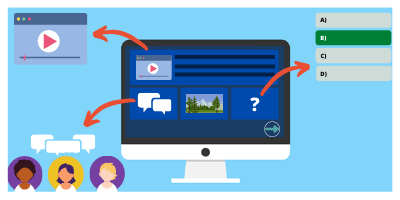Adding Interactivity: Going Further
Adding interactive learning activities can help improve student engagement, shifting away from passively absorbing knowledge, to active participation through online strategies such as collaboration, communication, gamification, and embedded elements that responds directly to student use or input. Below are some ideas you may wish to consider when enhancing interactivity.

![Adding interactivity banner Image text [adding interactive content]](https://digitaleducation.lincoln.ac.uk/files/2020/11/Adding-interactivity-banner.png)
A variety of media content can be used to engage students and can include elements such as: videos, audio as well as documents to supplement or add information. Adding media becomes more powerful when students can interact with that content and experience it on a deeper level. Interactive content can be single artefacts/objects, however, we find that it is useful when linked with multiple elements to form a framework/learning journey (see section below).
Below are some elements which, whilst not an exhaustive list, can be considered interactive:
- Navigation between items/objects
- Simulations
- Fill-in-the blank/ ordering activities
- Quizzes
- Image hotspots
- Drag and Drop activities
- Decision trees/scenarios
- Interactive videos
By adding these elements to your online teaching and learning you can stimulate acquisition and application of knowledge. Some of these interactive elements can also be used as a formative assessment to see the current understanding of your students.
![Meaingful and Purposeful Image text [Meaingful and Purposeful]](https://digitaleducation.lincoln.ac.uk/files/2020/10/26.png)
The most effective interactive objects usually have a clear purpose for every activity. Adding a clear purpose and direction for students helps to motivate them to complete elements. For example, adding ‘interactivity’ through the addition of several button clicks to reveal information, can seem to visually improve the display of information, but doesn’t serve a purpose or add value to the delivery. In reality, this is no more engaging than turning pages within a book, and depending on bandwidth speeds, possibly more frustrating.
To support you with thinking about interactivity, the purpose behind them and how this will help you motivate your students to complete them, below are some questions to consider when creating an interactive element for your students:
- What value will making this information interactive add for the students/staff? Be clear about the benefit to your student.
- Is there a tool that is available that I can link to instead of creating from scratch (i.e. adding a Talis elevate item or Microsoft forms formative feedback quiz)
- What activity will best enhance the learning interactively? Examples you could consider include:
- Web searches, with results collated within a shared online space (such as Padlet or OneNote), to be curated (potentially in groups with an online space such as MS Teams) and outcomes presented at the next face-to-face sessions.
- Branching decision-trees, that lead students through a series of questions exploring different options.
- Excel-based simulations, that encourage students to play with a series of parameters and draw conclusions on the outcomes.
- Inquiry-led problem-solving, inviting elaboration and exploration of a topic through open-ended questions that are debated through social learning tools.
- Simulations or online quizzes that facilitate regular practice of key skills.
- Discussion and debate around the topic or a problem, using asynchronous or synchronous technologies.
![Tools image text [tools]](https://digitaleducation.lincoln.ac.uk/files/2020/10/Tools.png)
To gather a rich variety of content types you can use:
- Popular video channels
- E-booked & Articles
- Audio
- Documentation
Some of the tools that you can use are:
- Quizzes – Microsoft Forms, Qualtrics, Poll Everywhere (for live quizes), Blackboard MCQ’s
- Talis Elevate – For interactive and discursive reading
- Websites – Simulations
- Collaboration on documents – Office 365
Even those these elements are interactive and can be used separately. We recommend using a framework to map out the student journey and to help link each activity together to provide clarity and meaning. (see …link to page).
XERTE
One interactive tool available at Lincoln, which lets you add accessible interactive elements is Xerte. Some examples are available on this website.
Xerte, is an award-winning open-source interactive learning development tool used in HE across the world. It can be used to create a series of pages with a variety of interactive elements, or just one activity. These can then be added to your VLE for use with your students.
This page is part of a collection. To see the other pages in the collection. Please click the button links below.
